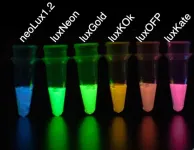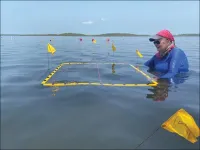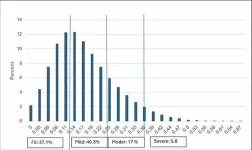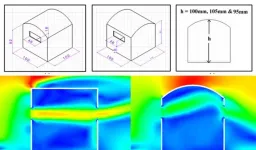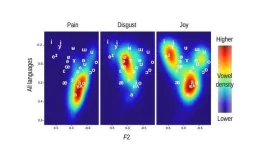(Press-News.org) Bioluminescence is the natural chemical process of light creation in some living creatures that makes fireflies flicker and some jellyfish glow. Scientists have long been interested in borrowing the secrets of these animals' light-producing genes to create similar effects in vertebrates, for a variety of biomedical applications.
UC Santa Cruz Assistant Professor of Biomolecular Engineering Andy Yeh is designing completely artificial proteins that produce bioluminescence to serve as a non-invasive method for bioimaging, diagnostics, drug discovery, and more. A new paper published in the flagship journal Chem reports on a new series of bioluminescent proteins designed by Yeh and his group, which are small, efficient, highly stable, and can produce multiple colors of light for real-time imaging in cellular and animal models.
This field of designing proteins that are not found in nature, called “de novo protein design", recently won a group of scientists the 2024 Nobel Prize in Chemistry, including David Baker, Yeh’s post-doctoral advisor. The proteins described in this paper were created using deep learning protein design softwares developed by Baker’s group, as well as protein structure prediction methods produced by DeepMind, whose founder also shared the Nobel Prize.
“We call this de novo protein design, because these proteins are computationally designed from scratch — it’s not found in nature and not even in the evolutionary trajectory. We demonstrated the use of the recently awarded Nobel Prize concept to build up new light-emitting enzymes, which serve as optical-based probes for biological studies,” Yeh said.
Better imaging probes beyond fluorescence
Many researchers and clinicians use fluorescence imaging techniques to understand disease, aid in drug discovery, and more. Fluorescence probes require external excitation light to shine. When external light shines on a tissue, every cell responds, creating a lot of background light that makes it harder to distinguish whatever the researcher or clinician is looking for.
Bioluminescent imaging is different in that it is “excitation-free” — the whole light emission process occurs on a chemical reaction level. Bioluminescence creates no background light response, making it much more effective for imaging features that may be deep within a tissue, like a tumor.
This paper shows that the researchers' light-emitting proteins work at the level of molecules, cells, and in a whole animal, making it more generalizable for different kinds of scientific research. It is especially suitable for non-invasive in vivo imaging because it can reveal information about biological processes deep within a tissue in real time without having to remove a sample from the body.
Visualizing multiple biological events
These specially designed proteins are “orthogonal,” with their reaction center highly tailored to the shape of the designed light-emitting molecule. This means that the designer enzyme does not react with other similar molecules that a researcher or clinician may be using at the same time.
“The designed reaction is very specific, so it can be used in combination with existing light-emitting enzymes, because the enzyme recognizes a different molecule,” Yeh said. “People already use light-emitting enzymes found in nature for a lot of biological research, and we are not reinventing the wheel. We are creating additional toolkits that work better and can be used in combination with the bioluminescence tools that the scientific community is familiar with.”
Yeh and his team also developed a method to shift the color of the light emitted by the proteins. Typically, these enzymes shine blue light, but through an efficient energy transfer process, the researchers made it possible to emit green, yellow, orange, and red light. This would allow a researcher or clinician to monitor various different biological features, called “multiplexing,” which is important for studying complex processes such as cancer development.
The new age of de novo protein design
De novo proteins are highly thermostable, meaning that they will not unfold at high temperatures, unlike other naturally occurring bioluminescent enzymes. A highly stable protein would be much easier to use for point-of-care diagnostics, as it would reduce the need for specialized shipping at low temperatures.
“We have now produced light-emitting enzymes with ideal protein folding that nature does not always need to optimize during evolution,” Yeh said. “This is the first instance in which we demonstrated that artificial light-emitting enzymes can produce enough photons in vertebrate animals for bioimaging. The computational protein design methods are becoming better and better, and so will the enzymes we design. I believe it is very true what David Baker said: this is just the beginning of de novo protein design.”
END
Bioluminescent proteins made from scratch enable non-invasive, multi-functional biological imaging
2024-11-12
ELSE PRESS RELEASES FROM THIS DATE:
New study links air pollution with higher rates of head and neck cancer
2024-11-12
DETROIT — A recent study published in the journal Scientific Reports correlates higher levels of pollutant particulate matter to higher occurrences of head and neck aerodigestive cancer.
The article, "Air Pollution Exposure and Head and Neck Cancer Incidence," is the work of a multi-institutional collaboration with researchers from Wayne State University, Johns Hopkins University and Mass General Brigham.
The study was led by John Cramer, Ph.D., associate professor of otolaryngology, and John Peleman, M.D., medical resident in the Department of Otolaryngology, in the Wayne State University School of Medicine. They collaborated with Mass General Brigham, an integrated ...
LSU researchers excavate earliest ancient Maya salt works
2024-11-12
The team was led by LSU Alumni Professor Heather McKillop, who first discovered wooden buildings preserved there below the sea floor, along with associated artifacts, and the only ancient Maya wooden canoe paddle in 2004.
Her key collaborator, Assistant Professor Elizabeth Sills at the University of Texas at Tyler, began working with McKillop as a master’s student and then as a doctoral student at LSU.
Since their initial discovery of wood below the sea floor in Belize, the team has uncovered an extensive pattern of sites that include “salt kitchens” for boiling ...
Building a diverse wildland fire workforce to meet future challenges
2024-11-12
Every year around this time, California’s wildland firefighters hold their breath as hot, dry winds threaten to spread flames across the state. As such conflagrations grow in size and severity throughout the Western U.S., the strain on fire managers has intensified. A new report from Stanford University’s Climate and Energy Policy Program provides a blueprint for fostering a more inclusive, diverse and well-supported workforce to meet the increasing need for fire mitigation and management.
“The wellbeing of the wildland fire workforce has ...
MBARI researchers discover remarkable new swimming sea slug in the deep sea
2024-11-12
MBARI researchers have discovered a remarkable new species of sea slug that lives in the deep sea. Bathydevius caudactylus swims through the ocean’s midnight zone with a large gelatinous hood and paddle-like tail, and lights up with brilliant bioluminescence. The team published a description of the animal, nicknamed the “mystery mollusc,” in the journal Deep-Sea Research Part I.
“Thanks to MBARI’s advanced underwater technology, we were able to prepare the most comprehensive description of a deep-sea animal ever made. We’ve ...
Decentralized social media ‘increases citizen empowerment’, says Oxford study
2024-11-12
Researchers from the Oxford Martin Programme on Ethical Web and Data Architectures (University of Oxford) have reported findings from a paper exploring the motivations and challenges in running decentralised social media such as Mastodon, concluding such platforms offer potential for increased citizen empowerment in this digital domain.
In their study, presented at the 27th ACM SIGCHI Conference on Computer-Supported Cooperative Work & Social Computing (CSCW) today, the researchers interviewed 16 administrators of Mastodon servers (otherwise known as instances), including those supporting marginalised and stigmatised communities. Their ...
Validating an electronic frailty index in a national health system
2024-11-12
“The classification of patients according to their level of frailty allows us to adjust prevention programs and focus our limited resources on the right action for the right person.”
BUFFALO, NY- November 12, 2024 – A new research paper was published in Aging (listed by MEDLINE/PubMed as "Aging (Albany NY)" and "Aging-US" by Web of Science), on October 24, 2024, Volume 16, Issue 20, titled, "Development and validation of an electronic frailty index in a national health ...
Combination approach shows promise for treating rare, aggressive cancers
2024-11-12
A research team led by UCLA Health Jonsson Comprehensive Cancer Center investigators has shown that that combining pembrolizumab, an immunotherapy drug, with standard chemotherapy can improve treatment outcomes for patients with small cell bladder cancer and small cell/neuroendocrine prostate cancer.
Small cell carcinomas can arise in various tissues—including the bladder, prostate, lung, ovaries and breast—and are known for their rapid progression, tendency to relapse after initial treatment and poor overall survival ...
Raise the roof: How to reduce badminton birdie drift
2024-11-12
WASHINGTON, Nov. 12, 2024 – Indoor badminton courts are often used for high-stakes tournaments, but even an enclosed court can affect the path of a birdie.
The airflow from a court’s heating, ventilation, and air conditioning (HVAC) system and cross ventilation plays a significant role in badminton. The lightweight feathered birdie passed between the players can be affected by low wind speed in the stadium. This is known as wind drift and has been at the center of multiple tournament controversies. While shutting ...
Ouch! Commonalties found in pain vocalizations and interjections across cultures
2024-11-12
WASHINGTON, Nov. 12, 2024 – There are an estimated 7,000 languages spoken worldwide, each offering unique ways to express human emotion. But do certain emotions show regularities in their vocal expression across languages?
In JASA, published on behalf of the Acoustical Society of America by AIP Publishing, an interdisciplinary team of linguists and bioacousticians led by Maïa Ponsonnet, Katarzyna Pisanski, and Christophe Coupé explored this by comparing expressive interjections (like “wow!”) ...
Income-related disparities in mortality among young adults with type 2 diabetes
2024-11-12
About The Study: In this cohort study of 1.2 million individuals ages 20 to 79 in South Korea, the risk of mortality with low income was most prominent among individuals with type 2 diabetes ages 20 to 39. These findings highlight the need for socioeconomic support to reduce income-related health disparities in younger individuals.
Corresponding authors: To contact the corresponding authors, email Sin Gon Kim, MD, PhD (k50367@korea.ac.kr) and Nam Hoon Kim, MD, PhD (pourlife@korea.ac.kr).
To access the embargoed study: Visit our For The Media website at this link https://media.jamanetwork.com/
(doi: ...
